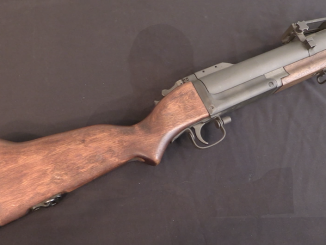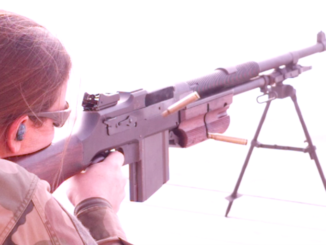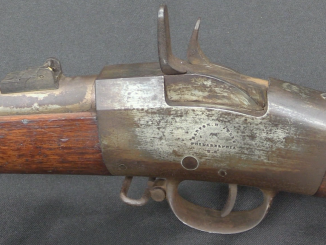Axel Peterson was a Swedish immigrant who became a very respected gunsmith in the Denver area in the late 1800s, and whose shop remained in business until World War 2. Peterson was best known for his smallbore .22 target rifles, but he did much more than just that. Like, for example, this .22 rimfire single shot Luger conversion. This is a really remarkably complex way to make such a pistol, which makes it all the more interesting to look at!
Related Articles

Grenade Launcher
M79: The Iconic “Bloop Tube” 40mm Grenade Launcher
Combat experience with the bazooka rocket launcher in World War Two and its larger versions in the Korean War convinced the US military that a better weapon was needed to give front-line troops a direct-fire […]

Light MGs
Colt R75A: The Last Commercial BAR (With Shooting)
The R75A was the last version of Colt’s commercial BAR, with 832 made between August and December of 1942 for the Netherlands Purchasing Commission. It was a derivative of the commercial R75 BAR, with a […]

Prototype
Barton Jenks’ Model 1867 Rolling Block Trials Rifle
These are lots #133 (from-scratch rifle) and #134 (muzzleloader conversion) in the upcoming RIA Premier Auction. It was scheduled for April, but has been postponed – check their web site for upcoming Online Only auctions […]

The Gunsmith should found himself in a vast amount of Lugers. However, l Liked the recoil to mainspring transtition best.
This proves the theory that nothing can be complicated enough (like the original Luger Pistol, which is ridiculously overcomplicated) that i couldn’t be made even more complicated by someone. Especially if one looks at the purpose: converting a magazine-fed 9mm handgun into a single shot .22.
I find only one word adequate for this: Madness.
You can only guess why he did not start off fresh. And he might have taken Luger as a master for general layout. He might have been ahead of Ruger. Hard to read someone’s mind, so much less if it is 100 years after.
I assume you’d go insane trying to understand why Kijiro Nambu made his Type 94 pistol in such a strange and complicated manner, especially the fragile “rabbit ears” barrel bushing support frame which acts against spring tension during the recoil phase of the firing cycle. Tons of “experts” say the Type 94 will blow itself to bits if it fired military grade ammunition, but this seems not to be true. And standard 8×22 Nambu is lethal enough if the intended victim is already within bad breath range.
Did I mess up?
“Type 94 will blow itself to bits if it fired military grade ammunition”
There exist quality-control, so passing such failed example is very low.
“standard 8×22 Nambu”
8×22 Nambu: 102gr @ 950fps = momentum 96900
9×17 Kurz (.380 Auto): 95gr @ 980fps = momentum 93100
Ballistic wise these cartridge are similar.
Similar, but somewhat more potent. The 8mm Nambu military loading used during WW2 was actually hotter than that, about 1000 fps when fired from the Type 94 and up to 1065 fps with the Type 14. So, it was actually more similar to 9x18mm Makarov.
There are modern .380 ACP factory loads that approach the same muzzle energy, but contemporary loads were milder. (The numbers you give for the .380 Auto are for a modern Federal factory loading, by the way. Historical muzzle velocities for 95 grain FMJ from about 3.5″ barrel were typically 900-950 fps).
@Euroweasel: I must admit that I should be more careful during data gathering.
@Cherndog: If you assume that 8×22 Nambu is too weak for military usage in automatic pistol then not only Imperial Japanese Army would qualify to this category during 2nd World War, but also Regio Esercito (Beretta Modello 1934, 9×17), Československá armáda (CZ 24, 9×17), Magyar Királyi Honvédség (Frommer Pisztoly 29 Minta, 9×17), Armée de Terre (SACM pistolet automatique mod. 1935, 7,65 Longue). Also notice that Type 94 Nambu was used by Japanese aircrews – Luftwaffe armed own pilots mainly with 7,65 Browning (.32 Auto) automatic pistol, so statement that 8×22 Nambu is too weak for use in automatic pistol during 2nd World War is dubious at best.
@Daweo: I was just nitpicking, which I have somewhat of a habit of doing. In general effectiveness there very likely was no noticeable difference between 8mm Nambu FMJ and .380 ACP FMJ, even if the former had somewhat higher muzzle energy. If anything, the .380 ACP may have been somewhat more effective due to slightly larger bullet diameter. Both of the cartridges meet or exceed the FBI penetration standard of 12″ through 10% ballistics gel. There are no actual tests with the wartime 8mm Nambu ammunition as far as I know, but I am sure it will meet the standard (after all, .32 ACP FMJ does).
It is noticeable that the 8mm Nambu was a significant improvement over the 9mm Japanese Ordnance revolver round, which lauched a 150 grain (9.8 gram) bullet at only 492 fps (150 m/s). It (the 9mm Revolver) was much weaker than contemporary European military 7.5-8mm revolver cartridges, which are usually considered quite weak by modern standards.
“why Kijiro Nambu made his Type 94 pistol in such a strange and complicated manner”
You should rather ask why Imperial Japanese Army accepted such design.
It was cheap (sort of) and came from a reputable designer of military pistols. And despite the design flaws, it worked pretty much as intended. Even the infamous sear bar defect was mostly theoretical and there are no verified accounts of the pistol even being accidentally discharged due to that design flaw. Not that a modern military would ever accept such a design, but the 1930s Imperial Japanese Army was not “modern” in many ways. They were, after all, still issuing swords to infantry officers and even NCOs, which were carried to combat instead of being purely ceremonial , and they were also still issuing 19th century style sword bayonets for rifles. Even more telling was the institutional difficulties in adopting the Hamada pistol, despite it being clearly a better design than the Type 94.
But high quality madness
“This proves the theory that nothing can be complicated enough (like the original Luger Pistol, which is ridiculously overcomplicated)”
So maybe we should make Heath Robinson Award for gun designer? For making things in most complicated manner without need to do so. I would suggest Shevchenko automatic pistol: http://modernfirearms.net/handguns/hg/ua/shevchenko-psh-e.html especially when you compare it to Makarov automatic pistol.
Argh! Was this made by someone drunk on vodka and high on stimulants?
Bleah … this gun is so ugly, even Ian would be wise to let it be forgotten until the end of time.
Another proof for that there are no boundaries to madness.
“no boundaries to madness”
In category of guns which entered production I would suggest MORS sub-machine gun: https://www.forgottenweapons.com/submachine-guns/wz-39-mors/
it was blow-back sub-machine gun firing 9×19, which isn’t nothing unusual, but it has:
-telescopic monopod in grip
-quick-change barrel, which anyway was so heavy that gunner would rather consume all his ammunition before need to change
-pneumatic RateOfFire reducing, despite that weapon was so long that bolt travel might be make longer, without elongating weapon
-magazine has capacity 24, not especially small when compared to other same era sub-machine gun (for example PPD-34 has capacity 25 as initially adopted), but is quite intriguing as this sub-machine gun seems to be optimized for high-intense fire (see quick-change barrel)
In the early 1990’s single shot .22 pistols came off ticket for a while here in france The SAPL company who made .22 silencers(up to 40.000 a year) produced a all aluminium or zamac .22 version of the german P38 in italy for the french market
It was single shot like this pistol and the mechanisum was a top break too
What was unusual about it was that it had an silenced barrel I have no idea if the barrel was ported but the gun was a failure as .22 single shot pistols were put back on ticket soon after the production started